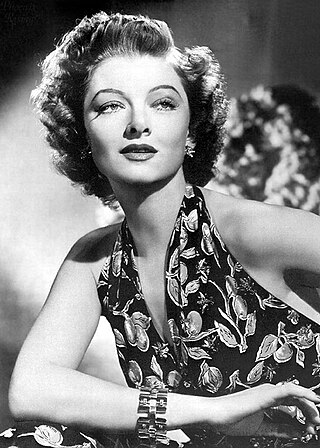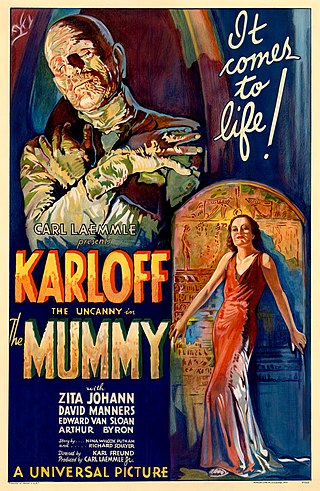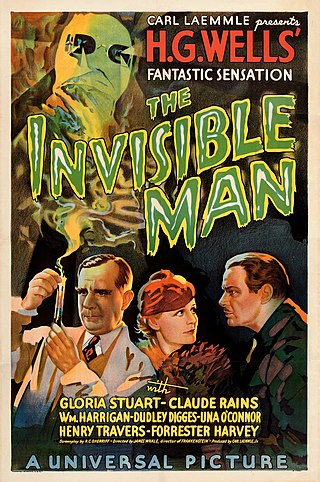
Dr. Fu Manchu is a supervillain who was introduced in a series of novels by the English author Sax Rohmer beginning shortly before World War I and continuing for another forty years. The character featured in cinema, television, radio, comic strips and comic books for over 100 years, and he has also become an archetype of the evil criminal genius and mad scientist, while lending his name to the Fu Manchu moustache.

Arthur Henry "Sarsfield" Ward, better known as Sax Rohmer, was an English novelist. He is best remembered for his series of novels featuring the master criminal Fu Manchu.

William Henry Pratt, known professionally as Boris Karloff and occasionally billed as Karloff the Uncanny, was an English actor. His portrayal of Frankenstein's monster in the horror film Frankenstein (1931) established him as a horror icon, and he reprised the role for the sequels Bride of Frankenstein (1935) and Son of Frankenstein (1939). He also appeared as Imhotep in The Mummy (1932), and voiced the Grinch in, as well as narrating, the animated television special of Dr. Seuss' How the Grinch Stole Christmas! (1966), which won him a Grammy Award.

Abbott and Costello Meet Frankenstein is a 1948 American horror comedy film directed by Charles Barton. The film features Count Dracula who has become partners with Dr. Sandra Mornay, as Dracula requires a "simple, pliable" brain to reactivate Frankenstein's monster. Dracula discovers that the "ideal" brain belongs to Wilbur Grey who is wooed by Mornay to the operating table, despite the warnings of Lawrence Talbot.

Myrna Loy was an American film, television and stage actress. As a performer, she was known for her ability to adapt to her screen partner's acting style.

The Mummy is a 1932 American pre-Code supernatural horror film directed by Karl Freund. The screenplay by John L. Balderston was adapted from a treatment written by Nina Wilcox Putnam and Richard Schayer. Released by Universal Studios as a part of the Universal Classic Monsters franchise, the film stars Boris Karloff, Zita Johann, David Manners, Edward Van Sloan and Arthur Byron.

The Fiendish Plot of Dr. Fu Manchu is a 1980 comedy film. It was the final film featuring star Peter Sellers and David Tomlinson. Based on characters created by Sax Rohmer, the film stars Sellers in the dual role of Fu Manchu, a megalomaniacal Chinese evil genius, and English country gentleman detective Nayland Smith.

The Invisible Man is a 1933 American science fiction horror film directed by James Whale based on H. G. Wells' 1897 novel, The Invisible Man, produced by Universal Pictures, and starring Gloria Stuart, Claude Rains and William Harrigan. The film involves a Dr. Jack Griffin (Rains) who is covered in bandages and has his eyes obscured by dark glasses, the result of a secret experiment that makes him invisible, taking lodging in the village of Iping. Never leaving his quarters, the stranger demands that the staff leave him completely alone until his landlady and the villagers discover he is invisible. Griffin goes to the house of his colleague, Dr. Kemp and tells him of his plans to create a reign of terror. His fiancée Flora Cranley, the daughter of his employer Dr. Cranley, soon learn that Griffin's discovery has driven him insane, leading him to prove his superiority over other people by performing harmless pranks at first and eventually turning to murder.
Denis Nayland Smith is a character who was introduced in the series of novels Dr. Fu Manchu by the English author Sax Rohmer. He is a rival to the villain Dr. Fu Manchu.

The Mysterious Dr. Fu Manchu is a 1929 American pre-Code drama film directed by Rowland V. Lee and starring Warner Oland as Dr. Fu Manchu. It was the first Fu Manchu film of the talkie era. Since this was during the transition period to sound, a silent version was also released in the United States, although only the sound version exists today. The film's copyright was renewed.
Ethnic stereotypes in comics have evolved over time, reflecting the changing political climate.

Drums of Fu Manchu (1940) is a 15-chapter Republic serial film based on the character created by Sax Rohmer. Though using the title of the ninth novel in the series, it actually is based on numerous elements from throughout the series to that point, cherry-picked by the writers. It starred Henry Brandon, William Royle and Robert Kellard. It was directed by the successful serial team constituee by William Witney and John English and is often considered one of the best serial films ever made.

The Walking Dead is a 1936 American horror film directed by Michael Curtiz and starring Boris Karloff, who plays a wrongly executed man who is restored to life by a scientist. The supporting cast features Ricardo Cortez, Marguerite Churchill, and Barton MacLane. The film was distributed by Warner Bros. Dr. Beaumont's use of a mechanical heart to revive the patient foreshadows modern medicine's mechanical heart to keep patients alive during surgery.

Fah Lo Suee is a character who was introduced in the series of novels Dr. Fu Manchu by the English author Sax Rohmer (1883-1959). She is the daughter of Dr. Fu Manchu and an unnamed Russian woman, sometimes shown as an ally, sometimes shown as a rival. The character featured in cinema and comic strips and comic books alongside her father, sometimes using another names, and she has also become an archetype of the Dragon Lady.
The Adventures of Dr. Fu Manchu is a syndicated American television series that aired in 1956. The show was produced by Hollywood Television Service, a subsidiary of Republic Pictures.

Behind the Mask is a 1932 American pre-Code crime/horror film directed by John Francis Dillon and starring Jack Holt, Boris Karloff and Edward Van Sloan.

The Blood of Fu Manchu, also known as Kiss of Death, Kiss and Kill and Against All Odds, is a 1968 British adventure crime film directed by Jesús Franco, based on the fictional Asian villain Dr. Fu Manchu created by Sax Rohmer. It was the fourth film in a series, and was preceded by The Vengeance of Fu Manchu. The Castle of Fu Manchu followed in 1969.
James Lee Wong, known simply as Mr. Wong, is a fictional Chinese-American detective created by Hugh Wiley (1884–1968). Mr. Wong appeared in twenty magazine stories and a film series of six, the first five of which starred English actor Boris Karloff as Wong, the last with Chinese-American actor Keye Luke in the role, the first Asian lead.
Zheng Bao Yu, is a fictional supervillain appearing in American comic books published by Marvel Comics. She is the daughter of Zheng Zu and the older half-sister of Shang-Chi.
















